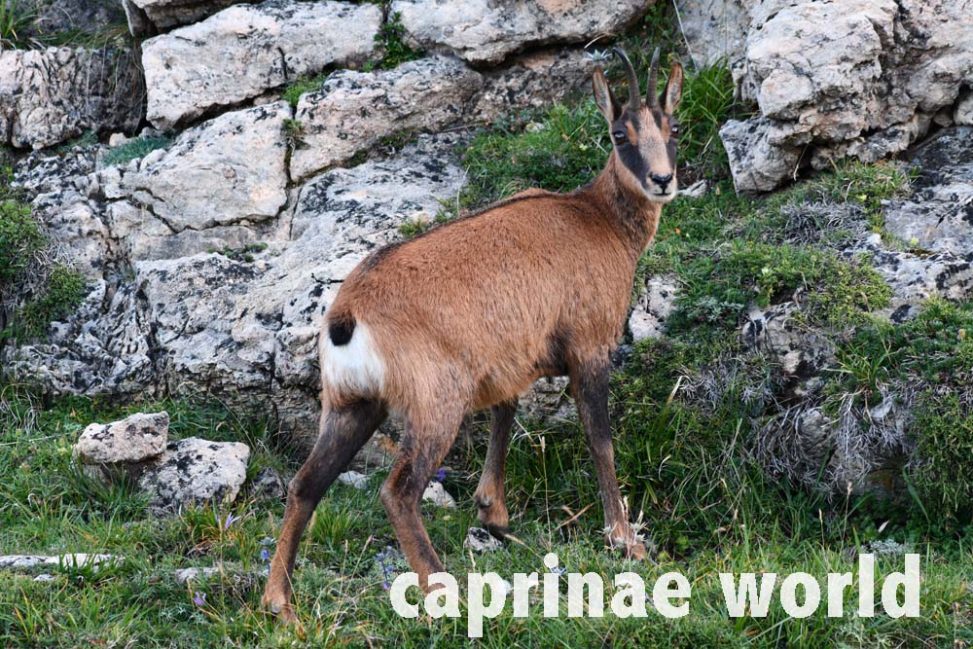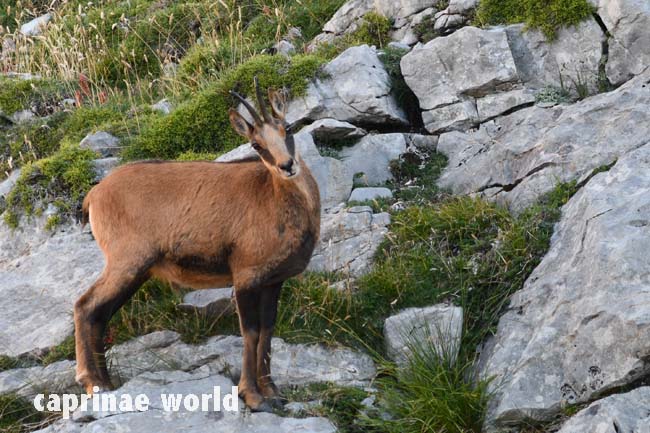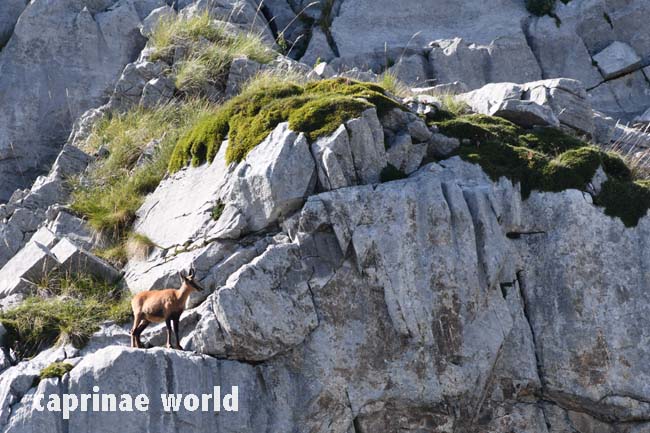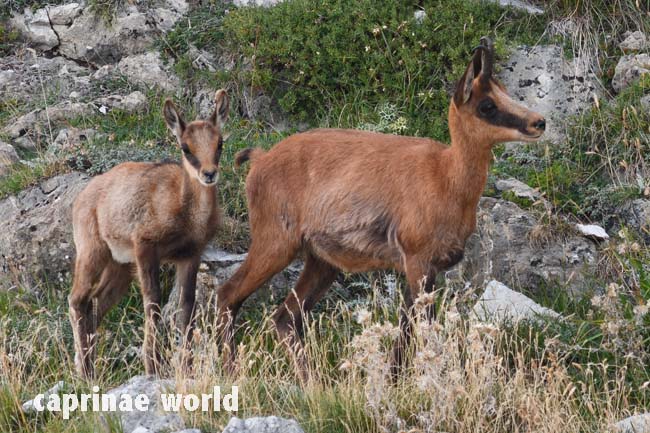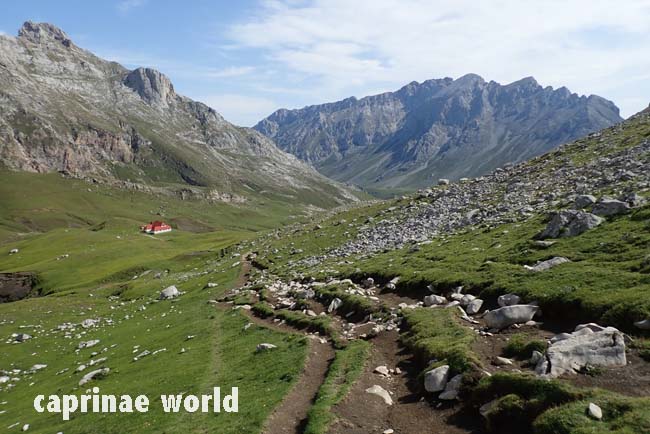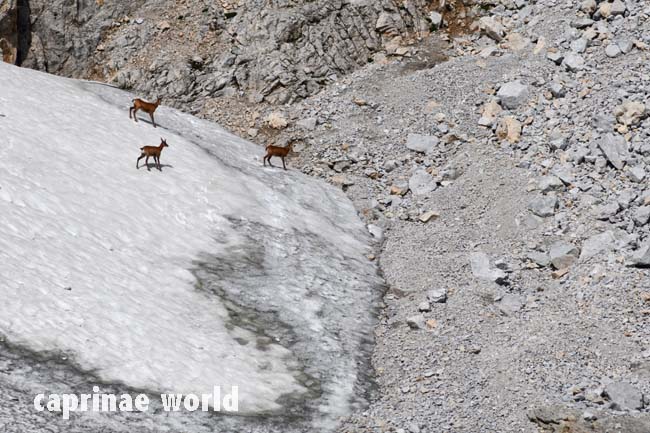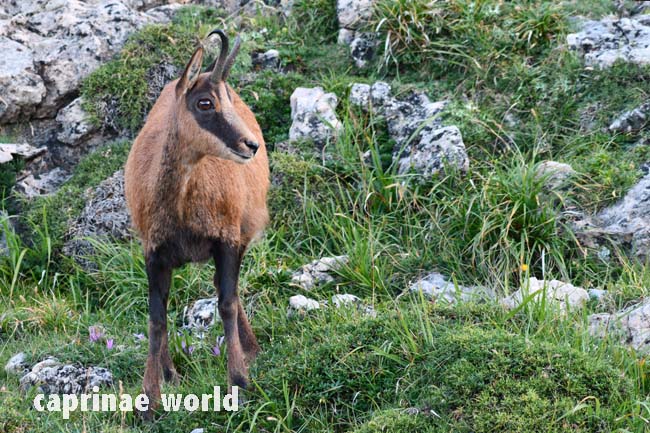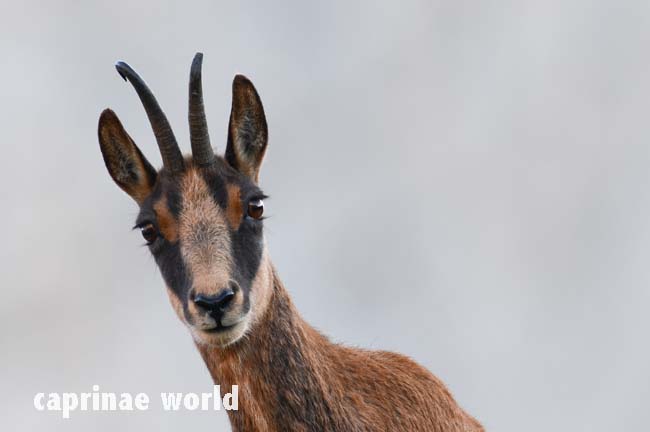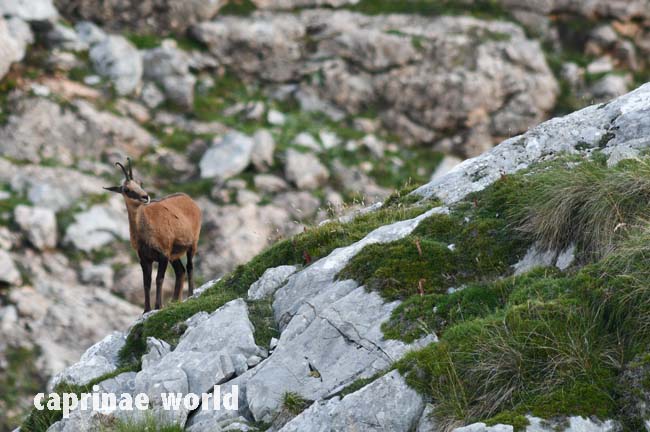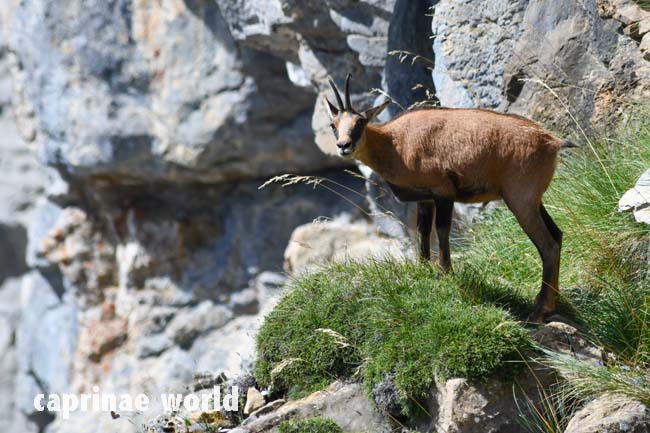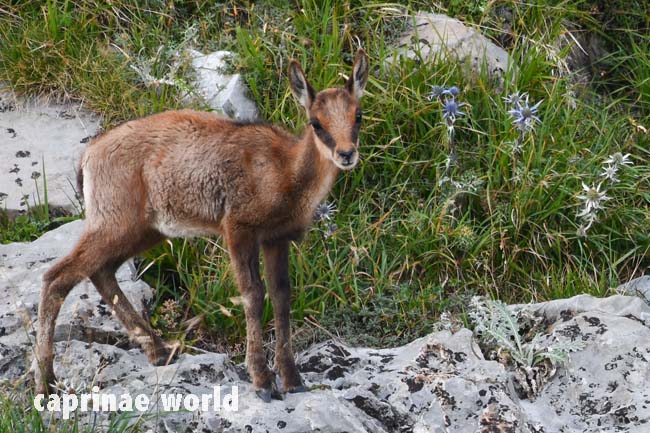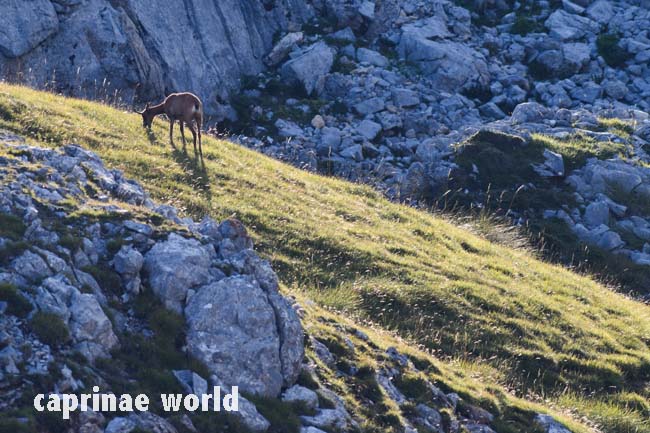- Rupicapra p. parva is, as its name suggests, much smaller than the other two Southern Chamois subspecies. In fact the Cantabrian Chamois is the smallest of all chamois.
Names
English: Cantabrian Chamois [2, 16]
French: Isard de Cantabrie [16], Chamois de Cantabria [2] – (the french term for Cantabria is „La Cantabrie“, therefore „Chamois de Cantabria“ could be a misnomer)
German: Kantabrien-Gämse [16], Kantabrische Gams [2] – (editor’s note: „Gams“ is hunter’s jargon)
Spanish: Rebeco cantábrico [2, 16]
Taxonomy
Rupicapra rupicapra parva, Cabrera 1910, Picos de Europa [4]
Diploid chromosome number: 58 [2]
Other (putative) scientific names and synonyms:
Rupicapra rupicapra parva, Cabrera 1910, Picos de Europa [2]
Rupicapra parva, Cabrera 1911, Picos de Europa [16]
Similar species / subspecies
The Cantabrian Chamois is, as its scientific species name „parva“ suggests, much smaller than the other two Southern Chamois subspecies [4, 16], as are its horns [16], which are also slimmer. [1]
The Pelage of the Cantabrian Chamois is redder in summer than the Pyrenean Chamois and tends to be grayer in winter. [16]
Castelló (2016) also mentions the tail as a distinctive feature, that he describes as dark reddish-brown in the Cantabrian Chamois – and not black as in the Pyrenean Chamois. [1]
Distribution
The Cantabrian Chamois (R. p. parva) occurs in the Cantabrian mountains in Northern Spain. [6, 16]
The distribution range of the Cantabrian Chamois is divided into two large population centres situated east and west of the 1.378 metres high Pass of Pajares in the Cordillera Cantabrica (Pérez-Barbería and Borja Palacios 2009). Apparently there is no migration between the groups. [2] Additionally there are further dissected habitat segments.
Description
The Cantabrian Chamois is the smallest bodied of all chamois. [2] Little sexual dimorphism occurs in body measurements. [16]
head-body: 90-130 cm [16]; males 104 cm (n=112); females 100 cm (n=40 cm) [2]
shoulder height: 76-80 cm [16]; males 74 cm (n=113), females 72 cm (n=41 cm) [2]
weight: 20-35 kg [16]; males 29,8 kg (n=113); females 24 kg (n=40) [2]
tail: 3-4 cm [16]
Colouration / Pelage
Damm and Franco (2014) state that the Cantabrian Chamois is in general very similar to the Pyrenean Chamois, but they also point out that the Cantabrian race has the lightest coloration pattern of all Rupicapra species. [2] It becomes not quite clear, but they probably refer to the winter coat.
winter coat: more clay-grey (instead of „darkish grey-brown“ as in the R. p. pyrenaica); darker on the back, chest, legs and flanks, with slightly lighter-toned areas on the hindquarters and shoulders. Individual variations occur, however. [2]
rump, throat, lower jaw and front of face in winter: yellowish-white
throat patch and facial reins in winter: well set off [2]
summer coat: reddish [2]
throat patch and facial reins in summer: ill defined and scarcely lighter than the general body color [2]
underparts: pale [2]
mid-dorsal line: slight stripe [16]
Horns
On average, the horns of Cantabrian Chamois are considerably smaller than those of Pyrenean Chamois. [2]
horn length, males: 15-20 cm [16]; max 24 cm [2]
horn basal girth, males: 6,4-9 cm [16], max 9 cm [2]
Horn size and the effects of hunting
Pérez-Barbería and Robles (2009) studied horn size in male and female Cantabrian Chamois (lenth, height, girth, spread and age) based on the formulae developed and used by the International Council for Game and Wildlife Conservation (CIC) and Junta Nacional de Homologacion de Trofeos de Caza (JNTH). The authors compared the horn size of hunted animals, under potential selection pressure, with those dying of natural causes in areas where chamois had been protected for over a century, with supposedly no selection pressure. Results: Horn length, height and girth of males in the hunted population did not differ from those in the protected areas, although spread did show some differences. Horn spread in females in the hunted area was greater than the spread in females in the protected population, while horn spread in males among the hunted population was less than that of males in the protected population. [2]
Habitat
The Cantabrian Chamois occurs at elevations of 400 to 2.400 metres in alpine and subalpine habitats with an element of precipitous terrain. Alpine meadow offer excellent feeding sites, but chamois have become equally adapted to forested habitats. The alpine-forested ecotone affords proximity to habitats that meet their foraging and thermal cover requirements. Proximity to steep, rugged, rocky habitats that affords security cover and escape terrain is especially required by femaels with young. [16]
Predators / Mortality
Cantabrian Chamois are preyed upon by wolf, lynx and bear [2]. But only Wolves (Canis lupus) are significant predators in some areas [16]. Currently the biggest threat is disease [2] – see also under „threats“
Food and feeding
Diets of the Cantabrian Chamois consist primarily of forbs and graminoids (grasses) with a peak in spring and higher intake of browse in winter. In spring the diet of the Cantabrian Chamois is 85 to 95 per cent graminoids; in winter it is 70 per cent browse. Females tend to consume higher percentages of forbs than males throughout the year. Females graze more actively than males except in winter, when no difference in feeding activity between sexes is detected. In alpine habitats, they favour northern exposures in summer and southern and western exposures in winter. Females show less fluctuations in kidney fat index than males. [16]
Breeding
rutting season: November-December [16]
gestation: 165-175 days [16]
female sexual maturity: at three years of age [16]
parturition: May-June [16]
young per birth: single [16]
fertility decline in females: after the age of eleven [16]
Activity pattern / competition
During early mornings in summer, Cantabrian Chamois move down from steep terrain where they spend the night, to feed in subalpine meadows. When the temperature rises, they seek thermal cover afforded by rocks, ledges and trees. They resume foraging during the cooler, late afternoon. [16]
When disturbed by humans, they may remain in rocky, precipitous terrain and avoid grazing in areas that afford more nutritive and abundant forage. In undisturbed areas such as national parks, they become accustomed to humans and forage close to campers and human habitations. [16]
Movements / social organisation
During warm seasons, mixed groups use alpine meadows; they use the same areas in winter as long as grass patches are available. When snow cover prevents grazing, they move to forested lower slopes. They typically remain in an area most of the year due to the abrupt altitudinal changes and lesser snow fall in the Cantabrian Mountains. Group size is variable and changes seasonally in relation to escape terrain, forage availability, and especially during the mating season, when males join female herds. Mean group size of females without kids is 5,59, that of males is 1,73, and of mixed groups is 8,9 individuals. The most densely populated areas have 6 to 15 ind /km². [16]
Status
IUCN classifies Rupicapra pyrenaica parva as „least concern“ (date assessed: 2008-06-30) [6]
In 2002 the population was estimated at ca.15.000 (Palomo and Gisbert 2002). [6]
Populations have been increasing since, especially in several nature reserves, including national parks. The animals even spread to areas where they were extirpated. In 2007/2008, an estimated 17.430 occurred in the wild. [16]
Threats
A virulent scabies outbreak in the 1990s caused a major population decline of the Cantabrian Chamois in the eastern part of its range. [16] It led to a hunting moratorium there between 2001 and 2003. [2]
Potential competition with domestic livestock is also a major concern. [16]
Conservation
The subspecies parva occurs in several parks / reserves. Some of them are [6]:
- Parque Nacional de Los Picos de Europa
- Montana de Covadogna
- Mampodre
- Saja
- Somiedo Hunting Reserve
- Sueve Hunting Reserve
Hunting
Hunting is permitted [16] and most Cantabrian populations are hunted (with the exception of within National Parks). Chamois is a major game species in Spain and is important socially and economically as a source of rural livelihoods. Hunting is carefully managed and revenue from hunting is returned to the local community. In Spain, regional governments set quotas, and hunting is not at an unsustainable level (J. Herrero pers. comm. 2006). [6]
For example, annual quotas are set between 3 and 5 per cent (male and female). [2] A combined total of 2000 Cantabrian and Pyrenean Chamois is harvested annually. [16]
Ecotourism
The Cantabrian Chamois certainly contributes to the nature experience within its distribution range. Some encounters have been mentioned in trip reports of wildlife watchers – mammalwatching.com.
Gallery
Literature cited
[1] Castelló, José R., 2016: Bovids of the World – Antelopes, Gazelles, Cattle, Goats, Sheep, and Relatives. Princeton University Press
[2] Damm, Gerhard R. and Franco, Nicolás, 2014: The CIC Caprinae Atlas of the World – CIC International Council for Game and Wildlife Conservation, Budakeszi, Hungary in cooperation with Rowland Ward Publications RSA (Pty) Ltd., Johannesburg, South Africa
[4] Groves, Colin and Grubb, Peter, 2011: Ungulate Taxonomy. The John Hopkins University Press
[6] Herrero, J., Lovari, S. & Berducou, C. 2008. Rupicapra pyrenaica. The IUCN Red List of Threatened Species 2008: e.T19771A9012711. http://dx.doi.org/10.2305/IUCN.UK.2008.RLTS.T19771A9012711.en. Downloaded on 30 January 2019.
[16] Wilson, D. E. and Mittermeier, R. A. [eds], 2011: Handbook of the mammals of the world. Vol. 2. Hoofed mammals. Lynx Edicions, Barcelona.

